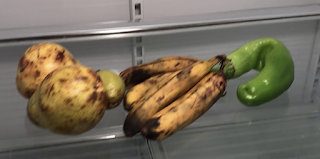This post and the other in this series are taken from an article I found online with the same name as the "Subject Line". They were written by Tove Danovich and posted on 9/16/15. The entire original post can be found here: http://bit.ly/2T8oqu0
----------------------------------------------------------------------------------------------------
Though tents and bunkers might suffice for backup shelter, storing food and water is a much more involved process. It's not quite as easy as running to the local grocery store the day before a storm and buying up all of the bread and kale left on the shelves. People who are getting into prepping often treat food and water storage as the true first step. While water can be stocked in the form of water bottles or rainwater-capture systems, food is not as easy as following a pre-made grocery list off the Internet.
When Bedford began preparing for the possibility of economic disaster in 2008, she quickly fell on food storage as a place to focus. She says that a lot of people do their own food storage — particularly homesteaders or people who live so far from the grocery store that it's inconvenient to go more than once a month — but that as a "typical suburban stay-at-home mom" she initially felt out of her depth. "It was a whole new world," she says.
The main issue is that stored food is only as useful as your willingness to eat it. "Food fatigue is a real thing," Bedford explains. If all that's in the pantry is rice and beans, the monotony of the diet would eventually make anyone lose their desire to eat.
To get a varied diet, Bedford advocates a three-layer approach to stocking the pantry. The first layer takes place at the grocery store — specifically in the canned food aisles. "The reason canned food is so important is that its shelf stable," Bedford says. That said, don't just purchase whatever is on sale. "Focus on things you'll eat and your family members will eat," she adds. And don't forget the spices: Adding new flavors to the same base ingredients is an easy way to combat food fatigue while sticking to a few pantry staples.
Next are the bulk foods which Bedford believes are where most of a prepper's time and money should be spent. Opening a can of ravioli might get you a meal, but there's not much in the way of choice. With freeze-dried meat, shrimp, yogurt, and cheese (almost every food seems to have been freeze-dried) and a healthy stockpile of various pastas, dried beans, and grain, "you can make hundreds of recipes," according to Bedford. For people who don't feel up to DIY recipe development, there are a number of resources to turn to. Many preppers blog and post individual recipes and tips on their websites.
Prepping is also a (small) cookbook genre with titles like The Survivalist Cookbook or The Prepper's Cookbook that speak directly to their intended audience. Plenty of other cookbooks focus on things like canned soup, jerky, or campfire recipes.
Finally, a good prepper wants to invest in some ready-to-eat meals. They're not all that different from the field rations given to soldiers and, as a result, are not something the average person wants to survive on entirely. "You'll get tired of them pretty quickly," Bedford says. She recommends that the RTE meals comprise no more than 20 percent of total food supplies.
But it's important to remember that even long-lasting foods can go bad. Henry doesn't just stock a pantry and forget about it, but rotates through the food during normal, non-emergency meals. "You don't want to find out when the power's out and the grocery store is closed that all your food expired five years ago," he says. "That's another reason why buying things you eat all the time is important." It also would ease the culinary transition into end-of-the-world dining if the family is still eating mom's beef stroganoff but with freeze-dried beef, powdered sour cream, and dehydrated mushrooms.
Bedford stresses that food storage does not have a one-size-fits-all approach. A city dweller simply doesn't have room to store a year's worth of food and water. Others can't afford to buy extra bulk and freeze-dried food — much less expensive gadgets or survival cooking gear. Even if someone could have a flock of goats and chickens doesn't mean they can take on that responsibility. "Not everyone can live that lifestyle and a lot of them don't want to," Bedford says.
One more to go friends,
e a lake

No comments:
Post a Comment